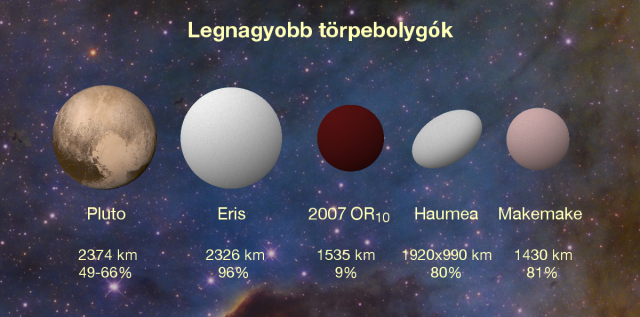Larger and heavier: Pluto’s remote brother examined by Hungarian researchers
Astronomers have identified the celestial body (225088) 2007 OR10 and according to calculations made by the Kepler and Herschel space telescopes it is the third largest dwarf planet of the Solar System.
2007 OR10 is the largest known celestial body of the Solar System without a name. It orbits far out in space, beyond Neptune and presently it is almost three times as far from the Sun as Pluto. Except for the fact that its surface was very red, we knew very little about it until the measurements taken recently. However, the K2 mission of NASA’s Kepler space telescope made it uniquely possible to watch this slowly moving celestial body for ten days without a break.
The original aim of the Kepler space telescope was to search for planets orbiting around other stars. This aspect remains one of the key areas within the K2 program, although to date it can see several other celestial bodies in the Solar System a fact which is well exploited by Hungarian researchers.
A surprisingly slow rotation
„Celestial bodies we had observed in the main belt and beyond Neptune made it possible for us to develop a software kit with which we could efficiently measure the light changes of slow targets in the Solar System,” said András Pál (MTA CSFK/ELTE), the main author of the scientific article and the developer of the software. „This is how we became able to follow the glow of objects perceived by the Kepler telescope with great precision and in unprecedented sequences of time.” With this method one could easily identify the changes in light which derived from the revolution of 2007 OR10 a motion surprisingly slow, around 45 hours.
As well as data gathered in visible light, researchers have also used the Herschel space telescope’s measurements in infrared wavelengths for the examination of the celestial body. One could thus determine the proportion of sunlight reflected by the dwarf planet relative to the amount of sunlight absorbed and later reflected as heat emission.
„It was by combining measurements of visible light versus infrared light that we could determine size and light reflective ability at the same time. From this data it turned out that 2007 OR10 was much larger than we had previously predicted; in fact it is the third largest known dwarf planet in the Solar System following Pluto and Eris,” said Csaba Kiss (MTA Research Centre for Astronomy and Earth Sciences) who had taken part in the program of the Herschel discovering celestial bodies beyond Neptune. According to the calculations of the researchers the diameter of the celestial body is 1535 kilometres, almost 250 kilometres more than we had previously assumed. A larger size means a darker surface: 2007 OR10 reflects less than 10 % of the Sun’s light in contrast with the other planets, e.g. Pluto and Eris, with their 50-90 %.
K2: new heights
The Kepler space telescope was reinstated just two years ago following its earlier failure. During this new period it studied a specific segment of space for 70-80 days. The past two years have shown that after having been born out of necessity, the program ultimately elevated the space telescope into new heights.
 A group picture of the largest dwarf planets of the Solar System. With its new size the 2007 OR10 has surpassed Makemake and Haumea. The lower numbers show the ability to reflect light. Source: András Pál, JHUAPL/SwRI (Pluto), Iván Éder (background)
A group picture of the largest dwarf planets of the Solar System. With its new size the 2007 OR10 has surpassed Makemake and Haumea. The lower numbers show the ability to reflect light. Source: András Pál, JHUAPL/SwRI (Pluto), Iván Éder (background)„K2 has become a valuable asset in practically all areas of astrophysics: from exoplanets and the physics of stars to extragalactic and Solar System researches. The Kepler has been designed to discover other types of interstellar planets around other stars rather than following close moving objects, but together with the methods of observation we have suggested we can achieve spectacular results with it too,” says Róbert Szabó (MTA MTA Research Centre for Astronomy and Earth Sciences), who uses the Kepler to study small as well as changing stars.
Hungarian researchers have published many technical articles on K2’s observations in the Solar System and K2 is going to cover many of their further campaigns. The scientific article describing their present results has been accepted to be published in the Astronomical Journal , while it is available for free reading here.
